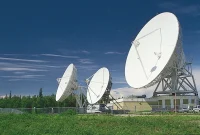
10+ Antenna Communication Type
Antennas are the unsung heroes of our interconnected world, enabling wireless communication across vast distances. Each antenna type has its own characteristics and applications, making them essential in various industries and everyday devices.
Dipole Antennas
Dipole antennas are perhaps the simplest form of antennas. They consist of two conductive elements, typically aligned along the same axis. Due to their straightforward design, dipole antennas are commonly used for radio and television broadcasting.
Yagi-Uda Antennas
Yagi-Uda antennas, also known as Yagi antennas, are popular for their high gain and directionality. They are frequently employed in television reception, Wi-Fi routers, and point-to-point communication.
Patch Antennas
Patch antennas, often found in devices like smartphones and GPS units, are compact and offer good radiation efficiency. They’re designed for specific frequencies and are widely used in applications requiring low-profile antennas.
Parabolic Reflective Antennas
Parabolic antennas use a curved reflector to direct signals towards a focal point. These antennas are found in satellite communication dishes and radar systems due to their ability to focus signals effectively over long distances.
Horn Antennas
Horn antennas come in various shapes and sizes and are known for their wide radiation patterns. They’re often used in microwave applications, including satellite communication and terrestrial microwave links.
Microstrip Antennas
Microstrip antennas are lightweight, low-profile antennas used in mobile devices and wireless systems. They can be easily integrated into circuit boards and offer versatility in design.
Helical Antennas
Helical antennas feature a three-dimensional spiral structure. They are used in applications where circular polarization is required, such as GPS receivers and satellite communication.
Log-Periodic Antennas
Log-periodic antennas cover a wide range of frequencies. They find use in television reception, radio astronomy, and EMC testing due to their ability to maintain consistent performance across multiple frequencies.
Phased Array Antennas
Phased array antennas consist of multiple radiating elements that can be controlled individually to steer the antenna’s beam electronically. They’re used in radar systems, satellite communication, and 5G technology.
Smart Antennas
Smart antennas incorporate signal processing techniques to enhance wireless communication. They adapt to changing signal conditions, improving signal strength and reducing interference.
MIMO Antennas
Multiple-Input Multiple-Output (MIMO) antennas are crucial for modern high-speed data networks. By using multiple antennas for transmitting and receiving, they enhance data throughput and network reliability.
Conclusion
From the basic dipole to the advanced MIMO antennas, the world of antenna communication offers a diverse range of options to cater to various connectivity needs. As technology continues to evolve, these antennas will play an integral role in shaping the future of wireless communication.
FAQs: Antenna Communication Type
- What is the main purpose of an antenna? Antennas are designed to transmit or receive electromagnetic signals, enabling wireless communication.
- Which antenna type is commonly used in satellite TV dishes? Parabolic reflective antennas are commonly used in satellite TV dishes due to their high gain and focusing capabilities.
- What is the significance of phased array antennas? Phased array antennas allow for electronic beam steering, making them highly versatile in applications like radar and communication systems.
- How do smart antennas improve wireless communication? Smart antennas adapt to signal changes, optimizing signal quality and minimizing interference for better communication performance.
- What is MIMO technology in antennas? MIMO technology uses multiple antennas to enhance data throughput and network reliability, crucial for high-speed data networks.



